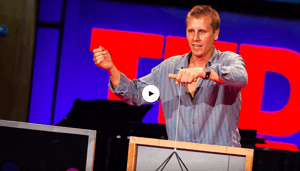In this memorable TED Conference, the neuroscientist Beau Lotto tackles a very important subject. As science and philosophy has taught us for centuries, seeing “things as they are” – the reality before our eyes for what it really is – is by no means simple. For centuries philosophers have been trying to understand if what we see really corresponds to what there is “out there”. Neuroscience has the answer: we do not see reality.
Our brain did not evolve to see reality: only 10% of neural connections are concerned with vision; the remaining 90% work non-stop to give a meaning to the information coming from the outside. And “giving a meaning”, in evolutionary terms, means building a model of the world that enables us to survive and reproduce to the best of our abilities. In practice, we actively build a world that appears real to us because it is useful to us. This is a world that naturally has a relationship with reality. But it is not reality.
As the philosopher Berkeley speculated at the beginning of the 18th century, we have no direct access to our physical world, other than through our senses. The brain did not actually evolve to see the world the way it is. It evolved to see the world the way it is useful to see it in the past. And how we see it is the product of continually redefining normality.
This is a huge problem, because it means that the same image could have an infinite number of possible real-world sources. In itself, sensorial information is meaningless because it could mean literally anything. And what is true for sensory information is true for information generally. There is no inherent meaning in information. It is what we do with that information that matters.
So, how do we see? We see by learning to see. The brain evolved the mechanisms for finding logical patterns, finding relationships in information, and associating those relationships with a behavioral meaning, a significance, by interacting with the world. For example, Lotto explains that nearly every living system has evolved the ability to detect light in one way or another. So, for us, seeing color is one of the simplest things the brain does. And yet, even at this most fundamental level, context is everything. And context tells us not only why we see what we do, but who we are as individuals, and who we are as a society.
This suggests that no one is an outside observer of nature. We are defined by our environment and our interaction with that environment, by our ecology. And that ecology is necessarily relative, historical and empirical. The conclusion, therefore, can only be a celebration of uncertainty. If our brain is a manifestation of our evolutionary history, we can change our way of seeing, thus becoming aware of our perceptions and learning to doubt also what “we see with our eyes”. Because only through uncertainty is there potential for understanding.

